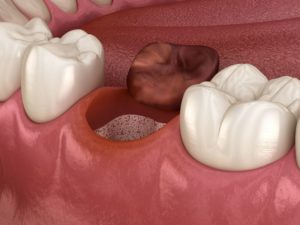
Appropriate aftercare is a crucial aspect of a successful tooth extraction. If you’ve just had a pearly white pulled, after all, then you’ve just experienced a procedure like any other that could result in complications. One common condition some patients develop is dry socket, which can be quite painful and frustrating! Keep reading to learn more about what it is and why it happens so that you can be sure to avoid it!
What Is Dry Socket?
It’s imperative that a blood clot forms over the extraction site if your dentist just performed an extraction. This clot protects the vulnerable nerve endings and bone below the now-missing tooth. Ideally, it stays put until your gums have fully healed.
Unfortunately, though, this blood clot sometimes dislodges and leaves the sensitive underlying areas exposed. When this happens, it’s referred to as dry socket. Not only is this incredibly uncomfortable, but it can also significantly add to your recovery period.
How Do I Know If I Have Dry Socket?
There are several symptoms that result from this unpleasant complication. If you notice any of the following, then it’s time to call the dentist:
- Severe pain at the extraction site within a few days of the procedure. It may even spread from your socket to your ear, eye, temple, or neck.
- The socket visibly looks empty.
- You can see bone underneath.
- Back breath or a foul taste in your mouth.
Depending on your specific circumstances, your dentist will either bring you back in to assess your situation or provide appropriate care instructions over the phone for you to follow.
How Can I Prevent Dry Socket?
Thankfully, there’s plenty you can do to keep that blood clot in place! You can prevent dry socket by:
- Avoiding straws. When you use a straw, you create suction between the movement of air and your cheek muscles that dislodges the blood clot. Wait a week before using one.
- Dropping bad habits. Those who smoke or use tobacco hinder their healing. The nicotine content decreases oxygen in the blood vessels as well as the amount of blood that can flow to the wounded area.
- Eating soft foods. Anything that’s hard or sticky can also displace the blood clot that’s so essential for recovery.
- Maintaining dental hygiene. You may need to wait 24 hours, but then you can resume your daily brushing and flossing routine. This keeps your mouth clear of infection-causing bacteria.
- Resting. Your body has just been through a somewhat intensive treatment, and you’ll need to be patient with yourself. Avoid strenuous activities as long as you’re able to until the extraction site has closed.
You can avoid quite a bit of discomfort by simply following whatever aftercare instructions your dentist gave you after your procedure. If you experience ongoing pain or other symptoms, then give them a call. They will be able to walk you through the next steps to get your recovery back on track!
About the Practice
Our dedicated dental team at Clear Coast Dental has been serving patients in the community for decades. We provide a full range of dental services from basic checkups and cleanings to more complex treatments like extractions and dental implants. We use a local anesthetic and a gentle touch to ensure you’re comfortable throughout your procedure and can walk you through proper aftercare. If you’d like a consultation, you’re welcome to request an appointment on our website or by calling (508) 812-9294.

